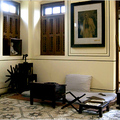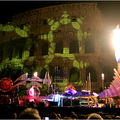
Sardinia's version of rush hour.
WE were not 10 miles out of Cagliari, the cosmopolitan capital of Sardinia, when the late-afternoon traffic halted. The cause was soon apparent: a flood of long-haired sheep, blank eyes framed by wild white dreadlocks, spilling slowly across the highway.
The sheep were pursued, if that’s the word, by an older gentleman in a dark cap, halfheartedly brandishing a stick. He was in no more hurry than they were. Rush hour, it seemed, could wait.
So could we.
Sardinia has many appealing features: deserted beaches of gold and azure, rocky landscapes strewn with Bronze Age stone igloos, sparkling resorts, unpretentious and friendly people with wonderfully expressive eyebrows.
We went there to count sheep. Also pigs, goats, donkeys and the occasional ostrich. In 2003, my wife, Fran Pado, and I spent our Sardinian honeymoon following the hollow tinkle of goat bells from one guest farm to the next, sampling the flavors of the land, sneaking sweet clover through fences to grateful livestock. This past May we returned, chaperoned by Violet, 2 ½, a happy consequence of the first trip.
While the countryside vacation has been around forever, agriturismo as a state-supported institution in Italy goes back to 1985, when the government moved to preserve the country’s beloved rural traditions, weakened by decades of postwar migration to cities. Farmers received tax breaks and other incentives to create rooms for visitors. Today there are more than 14,000 agriturismi in Italy. Nearly 600 are in Sardinia — not a ton, perhaps, compared with Tuscany, which has 3,200, but still more than a family can visit in a week, especially given the occasional woolly traffic jam.
An agriturismo is a real farm: most of what you eat and drink is produced on the premises, or at least nearby. The farmer is happy to let you see how sausage is made, as it were, and perhaps even get your hands dirty or milky at chore time. Many hosts also offer outdoorsy extras like horseback rides or guided hikes to ruins.
Accommodations vary from spartan to pleasant and can feel improvised: at one place, our big window commanded a view of the back of a wooden cabinet in a hallway; at another, an unenclosed shower tended to turn the whole bathroom into a wading pool. But with a combination petting zoo, fine-food atelier, nature preserve, playground and all-you-can-eat artisanal restaurant outside your door, there’s little reason to linger in your room.
The highway northeast from Cagliari wound through the lonely Sette Fratelli Mountains, which define Sardinia’s southeastern corner, the Sárrabus. Down a fennel-scented dirt road lay our first destination, Sa Perda Arrumbulada. Sa Perda Arrumbulada (the rolling stone in Sardinian, a dialect that is nearly its own language) is a bona fide organic farm, run by an agreeably hippieish, 50ish couple, Denise and Antonio Marongiu.
They showed us our simple, comfortable quarters off their living room, refreshed us with loquats — little peachy fruits with thick skin, sweet-tart flesh and a smooth round stone – and turned us loose. In the pigpen, we found a shrine to porcine beauty. Gray pigs, pink pigs, spotted pigs, pigs with lustrous golden hair that did not deserve to be called bristles, all frolicked in the mud.
For a family of vegetarians (O.K., two vegetarians and a cheater) the farm can be a challenging environment. Pork and lamb and veal are ubiquitous on the Sardinian menu, and some of us learned tough lessons about our animal pals. But if you’re going to have to survive sometimes on crisp rosemary-flecked flatbread, cheese and oiled pasta, Sardinia is a delicious place to do it. Fortunately for us, the Marongius spoke vegetarian. Dinner was a celebration of the fava bean. It started with raw favas fresh from the vine, dipped in a bowl of the farm’s grassy olive oil and some salt. I have never tasted anything so green. The main course was more favas, stewed in sun-dried tomatoes and onions, as complex as the raw beans were simple, tasting ancient and fresh like the earth.
Architecturally, most agriturismi are somewhat formal if not fancy affairs, with a separate dining room for guests and motel-like outbuildings. Sa Perda is just the Marongius’ house, with two spare rooms. Their living room was ours. Dinner is at their table.
Such intimacy has its perils. In my first chat with their 17-year-old son, Eros, he told me he planned to join the military after high school. I mentioned this to his parents over dinner after he had gone back to his room. It was apparently the first they’d heard of it. “Eros!” Denise shouted across the house. “So you’re going into a military career?” A lively discussion ensued.
After a revelatory visit to a honey farm — carob and arbutus flowers yield a bittersweet honey with a chocolaty, coffeed finish — we meandered 70 miles north to our next stop, Su Barraccu. There, the rooms were big and had adjoining bathrooms, but the difference between agritourism and ecotourism was apparent. Violet froze in her tracks when the owner’s daughter opened the pig barn door, revealing 150 sad-looking specimens corralled in cramped concrete-floored pens.
The puppylike brown-and-black-striped boar piglets tagging along after their mother outside seemed a lot more cheerful, and dinner, starring culurgiones — pillows of pasta fluffed with potatoes, mint, garlic and pecorino — was delicious. But we were glad to return the next day to Su Mugrone, one of the highlights of our first trip, 15 steeply sloped acres piled against a long curtain of fluted white-gray stone outside the town of Oliena.
We were welcomed back like family. One of the owners, Maria Asunto Selis, gave Violet the ornately embroidered hat off a life-size doll to try on and let her baby-sit for her infant son, Michele, while she made dinner. That night, the Selises took us into town to visit Maria Asunto’s mother-in-law, the maker of the hat. At her kitchen table, she opened a battered magazine between whose pages she kept different colored threads and ran a few cobalt stitches in a wedding shawl.
We met another guardian of the island’s handiwork traditions later in the trip, Gilda Garau, whose agriturismo, Sa Lorighitta, sits in the center of the village of Morgongiori. in Oristano province. Her farm-stay lacks a farm, but in her kitchen, Ms. Garau rolls and twists dough made from the local hard wheat into lorighitta, pasta shaped like tiny, tightly coiled necklaces. Each one was a toothsome miracle of texture, a rosary counted on the tongue.
About 80 miles away, perched on a high plain above the provincial capital of Nuoro, Agriturismo Costiolu would be the perfect setting for a magical-realist spaghetti western. One of the most established agriturismi on the island, it is run by three Costa brothers — Giovanni, the hardheaded but kindly boss; Giuseppe, the sentimental horse whisperer; and Pietro, the dashing sculptor, whose monolithic humanoid creations of baked scraped clay are scattered like grim jokes across the premises.
Costiolu is full of enchanted corners. Battered cheese pots hang from the branches of a dead tree in the courtyard formed by the arms of the salmon-painted main building. Next to a conical, twig-roofed smokehouse, an orange cat slept all day in the crook of a low bough. A plank swing hanging from the bough took in a dizzying view over rocky pasture and cork plantation.
In the afternoon, Giovanni invited us into a dark, cavelike kitchen where stalactites of pepper-coated salami and pancetta hung from the ceiling. A glowing mass of mozzarella rested in a pan of hot water. Giovanni formed two little vases of cheese, tied them on a string like balloons and handed them to Violet.
In the corner hung a bouquet of desiccated lambs’ stomachs, the source of the rennet that curdled the milk that made our cheese. I decided not to point them out to my companions.
Instead, I changed the subject. I asked Giovanni if the property had any nuraghi, the fortresslike stone structures built by Sardinia’s pre-Roman inhabitants that pop up everywhere on the island. “I’ll show you,” he said, and led us out to the pasture, apron strings dangling.
“Here,” he said, pointing to a clump of blocky boulders. At first glance, their positions seemed random — Sardinia can look like one gigantic nuraghe. But from the right angle, we could see the rough outlines of a stone enclosure. “Villagio,” he said. “Thousand years before Christ.”
Over two days, we worked out a comfortable routine: descending from our pretty, whitewashed room with wooden shutters and wooden beds for a breakfast built around honey, ricotta and pane carasau, the paper-thin crisp bread; watching from the the courtyard as the animals made their midmorning rounds; then off into the fields. Violet made friends with a 3-year-old and took long pretend rides with him on a disused tractor. Dung beetles rolled balls of dung along a dirt track. Sheep defied their sheepdogs’ efforts to maintain an orderly procession across the property.
Our last morning at Costiolu, Giovanni beckoned us into an outbuilding where he was mixing a batch of ricotta. We watched mesmerized as he stirred it with a long stick studded with pegs like a crude guitar. As the cheese formed, he handed out spoonfuls. It tasted like hot ice cream. The milky broth left over, he said, would be fed to the pigs.
As we made our way down the long, dusty driveway, it occurred to me that we were eating like the pigs of Sardinia. And that was a good thing indeed.






